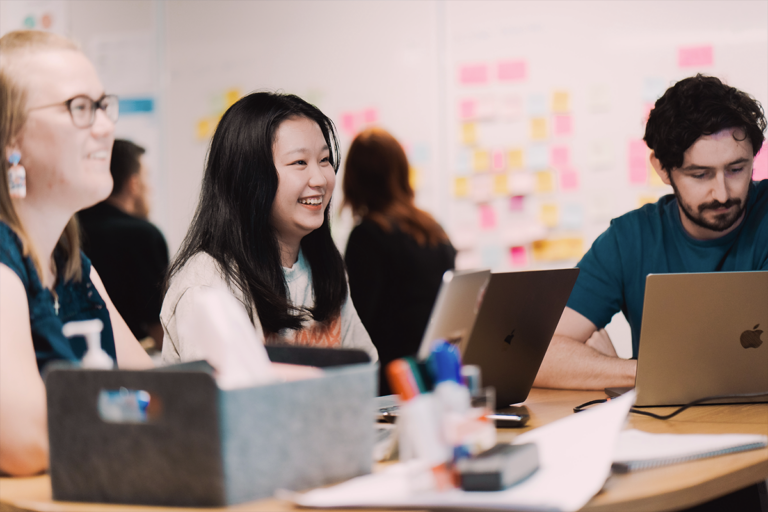At Magentus, our relationship to the word “experience” is multi-dimensional — it’s where the customer experience, user experience, employee experience and industry experience intersect to create a unique, connected experience that’s far more impactful than the sum of its parts.
We see a great “experience” as more than a great appointment booking workflow in Genie, a warm welcome email from support, or quick response to a piece of customer feedback on a training session. Rather, it’s the sum of all of the moments that matter — all the interactions between our people and our customers — that shape the way each one feels about the other.
When we talk about experience at Magentus, the concept isn’t limited to the way our products look.
A great product experience is also how it feels, how it sounds, how it works. It’s all of the pieces we pull together to create an experience greater than the sum of its parts, from how we answer the phone in support, to the rigour we apply to data security and product reliability.
A key way we create great experiences in all areas is by walking in your shoes before we make decisions, often meaning we trade in our own ideas for yours. To do this, we co-design our solutions alongside clinicians, practice managers and industry partners to better understand their perspectives and needs.
What is co-design and how does it benefit your medical practice?
Co-design is a system of working that combines professional expertise and first-hand experience to create an outcome or a product. The principles of co-design ensure that the expertise of our users is combined with the expertise of our team of designers and developers when we create new product solutions.
“Instead of looking inward at what our organisation knows, we open up the design process to our users,” says Tam McKenzie, Senior Product Designer at Magentus. “No matter if you’re a software expert or dealing with patients day-to-day, co-design in healthcare encourages us to work together and all opinions are respected as equal in the design of our products.”
Why we use co-design
One of our main goals is to help clinicians improve health outcomes for their patients through streamlined practice management. To be able to do that, we need to know what challenges our users face — and the best people to explain that to us are our customers.
“Co-design helps us design a more informed product for our customers, by making sure the subject matter is informed by our actual users.”
– Komal Rele, Senior Product Designer at Magentus
This co-design approach is spearheaded by the user experience (UX) team and goes beyond just consultation. It’s about collaborating equally with all stakeholders – from our software developers to medical receptionists – to ensure the very best solutions are conceived and delivered.
How we use co-design
We use a co-design approach on every single project we undertake. “Co-design is not a ‘nice to have’ — it’s part of our everyday process.”
– Michael Wilkins, Senior Product Designer
Whether it’s big or small, there is always an element of collaboration
Online surveys, phone interviews and on-site visits are just some of the ways our team connects with our customers on the challenges they are facing, their ideas and product requests. From there, the Magentus Practice Mangement UX team looks to prototype software solutions and use the principles of co-design in healthcare to run shared feedback sessions with stakeholders before any solution is implemented.
Case study: Prescribing module
The UX team at Magentus Practice Management needed to design a new prescribing module for our cloud product, Gentu. The team assembled a group of ten users who were subject matter experts and worked with them for four months to identify any problems with the existing solutions, any pain-points that other solutions haven’t addressed, and the expectations of the users. This research eventually became sketches.
“We started with a lot of ideas but through talking with our users, we were able to narrow them down. The concepts started off rough – we even did paper prototypes! However, as we refined our ideas over the four months through engagement with the users and the product and development teams, the design become more and more like it would look in Gentu.”
This process meant that the team was able to create a module that supported the Gentu user’s workflow and captured everything they would need it to do. Within the first week of the module’s release, over 300 prescriptions were generated, and even users who weren’t included in the research group commented on how much they liked the feature.
Why co-design in healthcare works
We are always looking to do things better — and differently. Unlike other software provider teams, the Magentus UX team uses the co-design process every day. As a result, users not only get access to new product features and early releases, they also get to contribute to the solutions that are built.
Tam knows that the users are really the experts of their experience.
“Often we find our customers use our product in ways we never could have dreamed of — so if we’re not getting out there engaging with our users so closely, we just wouldn’t know,” she says. “With co-design, you get to see the best-case scenario, worst-case scenario, and also things that change your perspective and you can adapt and change your approach.”
If you have any questions on how we conduct user research or want to be involved with future research groups, please contact us.
